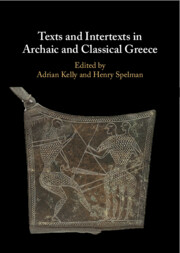Book contents
- Texts and Intertexts in Archaic and Classical Greece
- Texts and Intertexts in Archaic and Classical Greece
- Copyright page
- Contents
- Illustrations
- Tables
- Acknowledgements
- Contributors
- Abbreviations
- Introduction
- Part I Early Intertextuality
- Part II Lyric and Epic
- 4 Sappho’s Intertextual Geographies
- 5 Invoking Homer
- 6 Pindar, Bacchylides, Archaic Epic, and Intertextuality
- Part III Drama
- Part IV Conceptual Contexts
- Bibliography
- Index Locorum
- Index Rerum
6 - Pindar, Bacchylides, Archaic Epic, and Intertextuality
from Part II - Lyric and Epic
Published online by Cambridge University Press: 14 November 2024
- Texts and Intertexts in Archaic and Classical Greece
- Texts and Intertexts in Archaic and Classical Greece
- Copyright page
- Contents
- Illustrations
- Tables
- Acknowledgements
- Contributors
- Abbreviations
- Introduction
- Part I Early Intertextuality
- Part II Lyric and Epic
- 4 Sappho’s Intertextual Geographies
- 5 Invoking Homer
- 6 Pindar, Bacchylides, Archaic Epic, and Intertextuality
- Part III Drama
- Part IV Conceptual Contexts
- Bibliography
- Index Locorum
- Index Rerum
Summary
This chapter examines how Pindar and Bacchylides make use of early epic (esp. Homer) in their victory odes, from an explicitly ’intertextualist’ perspective. It discusses (inter alia) the meaning of ’Homer’ in the fifth century BC to the earliest audiences of Pindar and Bacchylides and adverts to the complexity and multiplicity of the audiences of their victory odes. It argues furthermore for the critical importance and benefits of intertextual analysis of Pindar and Bacchylides, especially the ways in which interaction with texts such as those of archaic epic should prompt a wider openness to intertextual investigation of victory odes.
- Type
- Chapter
- Information
- Texts and Intertexts in Archaic and Classical Greece , pp. 138 - 166Publisher: Cambridge University PressPrint publication year: 2024

